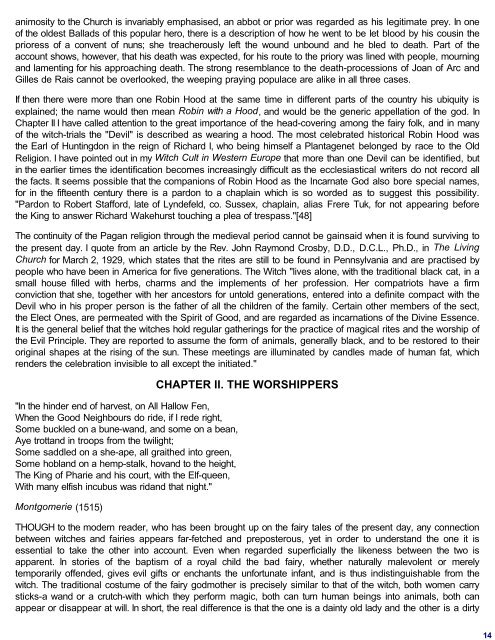THE GOD OF THE WITCHES - World eBook Library - World Public ...
THE GOD OF THE WITCHES - World eBook Library - World Public ...
THE GOD OF THE WITCHES - World eBook Library - World Public ...
You also want an ePaper? Increase the reach of your titles
YUMPU automatically turns print PDFs into web optimized ePapers that Google loves.
animosity to the Church is invariably emphasised, an abbot or prior was regarded as his legitimate prey. In one<br />
of the oldest Ballads of this popular hero, there is a description of how he went to be let blood by his cousin the<br />
prioress of a convent of nuns; she treacherously left the wound unbound and he bled to death. Part of the<br />
account shows, however, that his death was expected, for his route to the priory was lined with people, mourning<br />
and lamenting for his approaching death. The strong resemblance to the death-processions of Joan of Arc and<br />
Gilles de Rais cannot be overlooked, the weeping praying populace are alike in all three cases.<br />
If then there were more than one Robin Hood at the same time in different parts of the country his ubiquity is<br />
explained; the name would then mean Robin with a Hood, and would be the generic appellation of the god. In<br />
Chapter II I have called attention to the great importance of the head-covering among the fairy folk, and in many<br />
of the witch-trials the "Devil" is described as wearing a hood. The most celebrated historical Robin Hood was<br />
the Earl of Huntingdon in the reign of Richard I, who being himself a Plantagenet belonged by race to the Old<br />
Religion. I have pointed out in my Witch Cult in Western Europe that more than one Devil can be identified, but<br />
in the earlier times the identification becomes increasingly difficult as the ecclesiastical writers do not record all<br />
the facts. It seems possible that the companions of Robin Hood as the Incarnate God also bore special names,<br />
for in the fifteenth century there is a pardon to a chaplain which is so worded as to suggest this possibility.<br />
"Pardon to Robert Stafford, late of Lyndefeld, co. Sussex, chaplain, alias Frere Tuk, for not appearing before<br />
the King to answer Richard Wakehurst touching a plea of trespass."[48]<br />
The continuity of the Pagan religion through the medieval period cannot be gainsaid when it is found surviving to<br />
the present day. I quote from an article by the Rev. John Raymond Crosby, D.D., D.C.L., Ph.D., in The Living<br />
Church for March 2, 1929, which states that the rites are still to be found in Pennsylvania and are practised by<br />
people who have been in America for five generations. The Witch "lives alone, with the traditional black cat, in a<br />
small house filled with herbs, charms and the implements of her profession. Her compatriots have a firm<br />
conviction that she, together with her ancestors for untold generations, entered into a definite compact with the<br />
Devil who in his proper person is the father of all the children of the family. Certain other members of the sect,<br />
the Elect Ones, are permeated with the Spirit of Good, and are regarded as incarnations of the Divine Essence.<br />
It is the general belief that the witches hold regular gatherings for the practice of magical rites and the worship of<br />
the Evil Principle. They are reported to assume the form of animals, generally black, and to be restored to their<br />
original shapes at the rising of the sun. These meetings are illuminated by candles made of human fat, which<br />
renders the celebration invisible to all except the initiated."<br />
"In the hinder end of harvest, on All Hallow Fen,<br />
When the Good Neighbours do ride, if I rede right,<br />
Some buckled on a bune-wand, and some on a bean,<br />
Aye trottand in troops from the twilight;<br />
Some saddled on a she-ape, all graithed into green,<br />
Some hobland on a hemp-stalk, hovand to the height,<br />
The King of Pharie and his court, with the Elf-queen,<br />
With many elfish incubus was ridand that night."<br />
Montgomerie (1515)<br />
CHAPTER II. <strong>THE</strong> WORSHIPPERS<br />
THOUGH to the modern reader, who has been brought up on the fairy tales of the present day, any connection<br />
between witches and fairies appears far-fetched and preposterous, yet in order to understand the one it is<br />
essential to take the other into account. Even when regarded superficially the likeness between the two is<br />
apparent. In stories of the baptism of a royal child the bad fairy, whether naturally malevolent or merely<br />
temporarily offended, gives evil gifts or enchants the unfortunate infant, and is thus indistinguishable from the<br />
witch. The traditional costume of the fairy godmother is precisely similar to that of the witch, both women carry<br />
sticks-a wand or a crutch-with which they perform magic, both can turn human beings into animals, both can<br />
appear or disappear at will. In short, the real difference is that the one is a dainty old lady and the other is a dirty<br />
14















